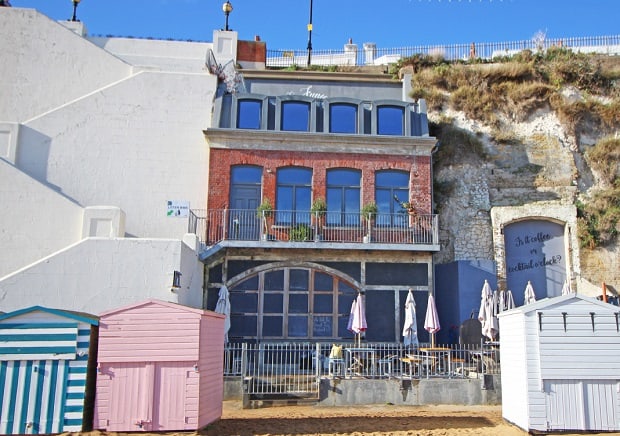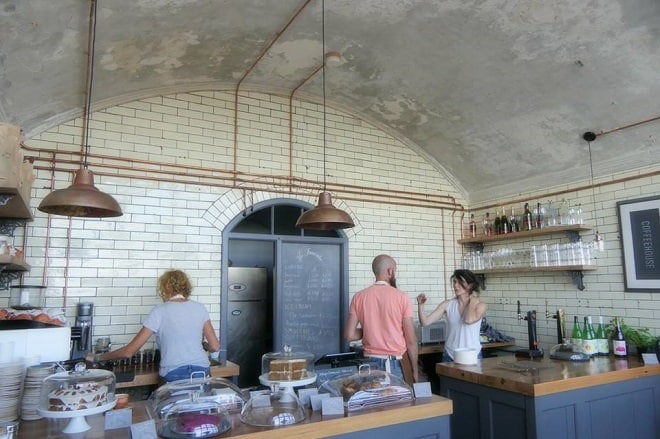
The Funicular Coffee House at the site of the former seafront shelter and toilets at Viking Bay is on the market with a 10 year lease.
Thanet council sold the freehold for the site as part of its asset disposal programme in 2017.
It was bought at auction for £350,000.

Owners Justin Van Oortmerssen and wife Annita Gkioka opened the boutique coffee house in June 2018 after carrying out renovation work.
The couple moved to east Kent after Annita took up a Clinical Neuropsychiatry PHD and lecturer placement at Canterbury university. They then spotted the Viking Bay property and moved to Broadstairs specifically for the venture.
Mr Ootmerssen said the business was named: “ (in) tribute to the Broadstairs funicular, the steepest funicular in the UK and one of only three left in the country of its kind.”
But now the couple have put the site on the market with Oakwood Commercial with a premium of £320,000 and £20,000pa rent.
Enquiries for a viewing can be made to Oakwood Homes online here
Last year the couple gained planning permission to build a restaurant and yoga studio at the adjacent Waterloo Shelter.
The Broadstairs funicular lift
The cliff railway at Viking Bay was built in 1910 by Messrs R Waygood and Co. They also built the Leas railway and others in Folkestone, the Clifton Baths railway in Margate, 3 vertical cliff lifts in Ramsgate and the lift at the Walpole Bay Hotel.
The bespoke designed installation at Broadstairs is a rare surviving example of a fully enclosed electric funicular lift system that counterbalanced a concrete weight travelling in a separate brick lined shaft, parallel to the track.
The single enclosed car could carry 12 people and ran along a 1600mm gauge/37 metre track at a steep 45 degrees. The funicular was the second steepest and shortest cliff railway in Britain, the first being the exposed system installed at the Clifton Baths in Margate (later developed into the Cliftonville Lido). It is also one of only three cliff railways in Britain that were constructed within a tunnel, of which it is one of two surviving.
The steepest operational funicular in Britain is the East Hill Cliff Railway in Hastings.
The lift service was initially operated by R Waygood and Co through a subsidiary company Cliff Lifts Limited. Their lifts at Margate and Ramsgate were also operated by the company for a short period before all became the responsibility of local councils or private owners.
From the 1960s numerous teddy bears and Disney characters were placed inside the main shaft of the Broadstairs funicular, which could be seen from the gated ends of the lift carriage while in transit.
The lift service was eventually under threat of closure in the 1970s due to the financial cost of maintenance and operation which the council were unable to continue subsidising.
Recognising the public demand and benefits for local businesses, the Broadstairs Hotel Association were able to secure ownership of the funicular lift from the authority and continued to operate the service with the original ageing system annually needing considerable service.
The last operator by 1991 before the lift would close for good was Ken Kneeshaw who fought hard to keep the lift operational until he no longer had the resources.
Recognising the historic value of the system within their company history, Waygood’s successor – the Otis Elevator Company, completed a full restoration of the electrical equipment and mechanical plant below the promenade housing, at their own cost in 1991.
But disaster struck not long after when a storm led to the destruction of the original roof upon the promenade housing, allowing water into the electrical equipment below.
Damaged beyond repair, the Otis project was rendered as a loss for both Broadstairs and the company. Further funding to restore the original carriage and track was unavailable.
History with thanks to the Broadstairs Cliff Railway page. Read the full account here

